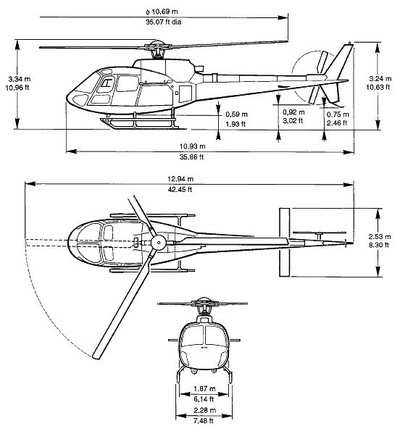Move Prompted By An Accident Involving An AS350B2
 The FAA has issued an Emergency Airworthiness Directive (EAD),
prompted by several reports of cracking in a tail gearbox (TGB)
control lever, part number (P/N) 350A33-1058-03, including an
accident involving an AS350B2 helicopter. An investigation revealed
that a few surface anomalies may lead to a crack in the TGB control
lever. This condition, if not detected could result in failure of
the TGB control lever, loss of tail rotor control, and subsequent
loss of control of the helicopter.
The FAA has issued an Emergency Airworthiness Directive (EAD),
prompted by several reports of cracking in a tail gearbox (TGB)
control lever, part number (P/N) 350A33-1058-03, including an
accident involving an AS350B2 helicopter. An investigation revealed
that a few surface anomalies may lead to a crack in the TGB control
lever. This condition, if not detected could result in failure of
the TGB control lever, loss of tail rotor control, and subsequent
loss of control of the helicopter.
The FAA has reviewed Eurocopter Emergency Alert Service Bulletin
(EASB) No. 05.00.62, for Model AS350 helicopters and EASB No.
05.00.57 for Model AS355 helicopters. Both EASBs are Revision 1,
dated April 23, 2010, and both describe procedures for a visual
inspection of the TGB control lever for a crack that must be
performed after the last flight of each day and prior to exceeding
10 flying hours for each inspection. The EASBs also describe a
rework procedure for affected TGB control levers which must be
accomplished within 660 flying hours or no later than June 30,
2011, or before installing an affected TGB control lever on a
helicopter. The one Eurocopter EASB contains four different service
bulletin numbers (Nos. 05.00.62, 05.00.57, 05.00.38, and 05.00.35)
applicable to four different Eurocopter model helicopters. EASB No.
05.00.38 relates to Eurocopter Model AS550 helicopters, and EASB
No. 05.00.35 relates to Eurocopter Model AS555 helicopters.
Eurocopter Model AS550 and AS555 helicopters are military models
and are not type-certificated in the United States. This AD does
not incorporate EASB No. 05.00.38 nor EASB No. 05.00.35.
The European Aviation Safety Agency (EASA), which is the
Technical Agent for France, notified the FAA that an unsafe
condition may exist on these helicopter models. EASA advises of a
crack discovered in a TGB control lever, which could lead to a loss
of tail rotor control and subsequent loss of control of the
helicopter. EASA classified the service bulletin as mandatory and
issued EASA Emergency AD No. 2010-0082-E, dated April 27, 2010, to
ensure the continued airworthiness of these helicopters. This AD
differs from EASA Emergency AD No. 2010-0082-E as follows:
- The FAA includes the Eurocopter Model AS350C and AS350D1
helicopters that may contain the affected TGB control lever.
- The FAA uses the term “hours time-in-service”
rather than “flight hours”.
- The FAA does not require replacing the TGB control lever within
660 hours TIS or 14 months, but instead offer optional terminating
actions for the repetitive inspection requirements.
- The FAA does not require you to contact Eurocopter if a crack
is found during any inspection.
These helicopter models are type certificated for operation in
the United States under the provisions of 14 CFR 21.29 and the
applicable bilateral agreement. Pursuant to the applicable
bilateral agreement, EASA has kept the FAA informed of the
situation described. The FAA has examined the findings of EASA,
reviewed all available information, and determined that AD action
is necessary for products of these type designs that are
certificated for operation in the United States.

This unsafe condition is likely to exist or develop on other
helicopters of these same type designs. Therefore, this AD
requires, within 10 hours time-in-service (TIS), and thereafter at
intervals not to exceed 10 hours TIS, a visual inspection for
cracking in the TGB control lever in accordance with the EASB. If a
crack is found, replacing the cracked TGB control lever with an
airworthy TGB control lever is required before further flight.
Optional terminating action for the inspection requirements of this
AD can be accomplished by either:
- Replacing a TGB control lever with an airworthy TGB control
lever that is marked with an “X” near the P/N.
- Stripping the rework area “B” as shown in Figure 4
of each EASB and performing a dye-penetrant inspection on that area
for a crack.
If no crack is found, reworking and marking the TGB control
lever before further flight is required. If a crack is found,
before further flight, removing and replacing the cracked TGB
control lever with an airworthy TGB control lever is required.
These actions are required to be accomplished in accordance with
specified portions of the EASBs described previously.
 ANN's Daily Aero-Linx (04.13.24)
ANN's Daily Aero-Linx (04.13.24) ANN's Daily Aero-Term (04.13.24): Beyond Visual Line Of Sight (BVLOS)
ANN's Daily Aero-Term (04.13.24): Beyond Visual Line Of Sight (BVLOS) Airborne 04.09.24: SnF24!, Piper-DeltaHawk!, Fisher Update, Junkers
Airborne 04.09.24: SnF24!, Piper-DeltaHawk!, Fisher Update, Junkers Aero-News: Quote of the Day (04.14.24)
Aero-News: Quote of the Day (04.14.24) ANN's Daily Aero-Term (04.14.24): Maximum Authorized Altitude
ANN's Daily Aero-Term (04.14.24): Maximum Authorized Altitude




